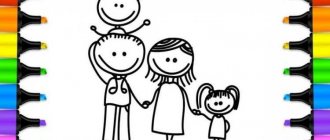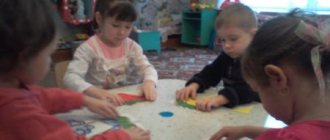Nursery rhymes about wild animals
The wind rustles the trees, our hedgehog is in a hurry to go home. And a wolf meets him, a click hits the hedgehog with his teeth. The hedgehog showed his needles, the Wolf ran away in fear.
Hedgehog, hedgehog, eccentric, I sewed a prickly jacket. He wants to play with us, count all the guys.
Who lives in the dark forest? Aren't you afraid of the bear and the fox? Who clicks with sharp teeth? Did you guess it? It's a wolf!
Shadow-shadow-shadow Shadow-shadow, shadow, Above the city there is a fence. The animals sat under the fence and boasted all day. The fox boasted: “I am beautiful to the whole world.” The bunny boasted: “Go and catch up!” The bear boasted: “I can sing songs!” The hedgehogs boasted: “Our fur coats are good!”
The old hare is mowing the hay The old hare is mowing the hay, And the fox is raking it up. The fly carries hay to the cart, and the mosquito throws it. They took me to the hayloft - a fly screamed from the cart: “I won’t go into the attic, I’ll fall from there, I’ll break my little leg, I’ll be lame.”
Snail Snail, snail, Stick out your horns, I'll give you, snail, a piece of pie! Crawl along the path, I'll give you some cakes.
Ladybug Ladybug, Fly to the sky, Bring us bread, Black and white, Just not burnt.
Nursery rhymes about pets
The cat has a kitten, the duck has a duckling, the bear has a bear cub, the horse has a foal, the pig has a piglet, the sheep has a lamb, the cow has a calf, the hen has a chick, the dog has a puppy, and the mother has a son .
I will tie the goat to the white birch tree, Stop, my little goat, stop, don’t butt, White birch, stop, don’t sway.
I bought a ram bagel At the market early in the morning I bought a ram bagel: For the lambs, for the sheep TEN poppy rings, NINE dry cakes, EIGHT buns, SEVEN flatbreads, SIX cheesecakes, FIVE shortcakes, FOUR crumpets, THREE cakes, TWO gingerbreads AND ONE kalach I bought - Not to myself I forgot! And for the wife - sunflowers.
The piggy piggies are unhappy: “Oink-oink-oink!” they shout and scream, “We don’t want noses like that!” Only two holes stick out.
Goat-goat: -Me-me-me! I'm learning to count in my head! What is two plus five?... Me-me-me, I forgot again! Mom will be very upset! Me-me-me - I’m running to study.
The old man was walking along the road. The old man was walking along the road, along the road, along the road. He found a goat without horns, without horns, without horns. Come on, goat, let's jump, jump, jump, and jump with our legs, jump, jump. Come on, let's spin around, spin around, spin around. And we'll be friends forever, we'll be friends, we'll be friends. And the goat butts, butts, butts, And the old man swears, swears, swears.
Nursery rhymes about a bunny for children
Little Bunny, come into the garden, Little Gray, come into the garden. Bunny, bunny, come into the garden, Gray, gray, come into the garden!
Little Bunny, pick the color, Gray, pick the color. Bunny, bunny, pick the color, Gray, gray, pick the color!
Zainka, make your wreath, Gray, make your wreath. Bunny, bunny, make your wreath, Gray, gray, make your wreath.
Little bunny, dance, Gray, dance. Bunny, bunny, dance, Gray, gray, dance.
You can sing this nursery rhyme and perform the movements together with the bunny. And most importantly, it’s easy to come up with a continuation of the nursery rhyme yourself and diversify the movements.
The gray bunny is sitting. The gray bunny is sitting and wiggles its ears. That's how, that's how He moves his ears!
It's cold for the bunny to sit, I need to warm my little paws. That's it, that's it. We need to warm our little paws!
It's cold for the bunny to stand, the bunny needs to jump. Like this, like this The bunny needs to jump!
The wolf scared the bunny! The bunny immediately ran away!
***
Oh, you, oblique hare Oh, you, oblique hare - like that! Don't follow me - like that! You'll end up in the garden - just like that! You'll gnaw off the whole cabbage - like this, When I catch you - like this, When I grab you by the ears - like this, And I'll twist your tail - like this!
Bunnies Bunnies run across the meadow, then the forest. The strawberries are being picked, hop and hop! Jump and jump! Here the clearing is softer than silk, Look around, look around! Beware of the dashing wolf, Beware, beware! The bunnies fell asleep sweetly, the forest is noisy! The forest is singing! - Run away without looking back: The wolf is coming, the wolf is coming!
In the garden there is noise-noise-noise, Bunny-bunny: crunch-crunch-crunch, Jump-jump-jump on the stumps, on the stumps, Ate a carrot - yum-yum-yum!
↑ What is pestushka
Pestushki include playful interaction with a child, when an adult performs movements “for him”, playing with his arms and legs. The baby may still not be able to perform such movements as turning the body, he cannot purposefully use his hands, he cannot sit down, crawl, or stand on his own - all this will come to him during the 1st year of life. It is during this period that the mother nurtures the baby: plays with his hands, strokes the baby’s tummy, and makes “stomps” with his legs. The mother caresses the awakened baby, touching her with light massage movements, and gently says:
“Stretchers, Porostunyushki, Across the fat one, And in the legs - walkers, And in the arms - grabbers, And in the mouth - a talker, And in the head - a mind.”
Or:
“Stretch! Little ones! Across the fat girl, Hands are grasping. Legs are runners."
Massage, turning the head, throwing arms over the head, waving the hands with mother’s help, etc. - all this not only physically improves the baby’s health, but also gives him a lot of pleasure. If at the same time the mother cheerfully says:
“I knead, knead the dough, There is room in the oven, Bake, bake a loaf! Little head - go ahead, go ahead!”
—
what is happening causes an emotional “outburst” in the child, a need to contact an adult, and most importantly, a desire to repeat those movements that he cannot yet perform on his own. With each repeated play, the mother feels increasing activity in the baby’s movements. Listening to the mother’s affectionate recitative, the baby anticipates the play movements, laughs and already puts his head up, stretches out his arms, stretches out his legs, etc., waiting for a familiar turn in the game. So, with the help of pestles, the baby’s playful “training” begins.
Also entertaining for children is rocking on their feet, “jumping” and swaying on their mother’s or father’s lap, grandmothers imitating a horse race, riding down a mountain, dancing, etc. Of course, such games are useful for older children, when the baby can already sit well and rise to his feet on his own:
Let's go, let's go With nuts, with nuts! Let's gallop, gallop with rolls, with rolls! Leap, skip, over bumps, over bumps - into the hole - bang!
The adult throws the child on his knees, and then pretends to lower him down (pinches him with his knees and puts him back on the “horse” (“sleigh”, “cart”, etc.).
The road is good, The road is good, Something has become worse, Something has become worse, Playing around, playing around, Playing around, playing around, On the bridge, under the bridge, On the bridge, under the bridge, Thump in the hole!
Exercises that prepare a child for mastering walking are useful.
Toki-toki-toshki, I forge, I forge legs. Antoshka's legs are driving along the path, The path is crooked, There is no end, no edge.
While reciting the rhyming lines, the mother alternately spanks the baby's feet, which reflexively react to light touches, as he lies on his back. This is how an adult forms a sense of the rhythm of walking when stepping with one leg or the other.
When a child begins to master walking, other pestles come to the rescue, for example:
Ta-ta-ta, ta-ta-ta, A cat married a cat; The cat walks along the bench, leads the cat by the paws, stomps and stomps on the bench, tugs and tacks by the paws.
While pronouncing these verses, the mother holds the baby by the arms and, stepping back, carefully leads him along. The rhythm of the verse is set by the ri, the “tsap-tsap” coincides with the steps of the stepping child.
The baby can be led in another way: an adult holds him from behind by the armpits and, spreading his legs wide apart, encourages him to step with his legs.
Big feet Walked along the road: Top-top-top, Top-top-top. Little legs ran along the path: Top-top-top, top-top-top! Top-top-top, top-top-top!
Pestlers are also entertaining for the child, thanks to which he learns to make rhythmic clapping with his palms. The adult grabs the baby’s hands and, bringing them closer, says:
“Okay, okay, where have you been? - At Annushka's. What did you eat? - Pancakes. Where are the pancakes? “We ate... No pancakes!”
(The child’s arms are spread to the sides.)
Game continues. The adult suggests going to Panichka:
Okay, okay, where have you been? - At Panechka's. What did you eat? -Gingerbread! Where are the gingerbread cookies? Ate... No gingerbread!
(The child’s arms are spread to the sides.)
Then the adult offers to “go” to Mikeshka for some nuts, then to Troshka for some potatoes, and then to Senechka for some seeds (by analogy). The important thing is that while playing, the child learns to fold his hands when he hears the word “okay” and perform playful movements with his hands in the rhythm of the song.





